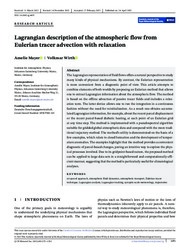Lagrangian description of the atmospheric flow from Eulerian tracer advection with relaxation
Persistent URL: http://resolver.sub.uni-goettingen.de/purl?gldocs-11858/10938
 |
Dokument öffnen: |
The Lagrangian representation of fluid flows offers a natural perspective to study many kinds of physical mechanisms. By contrast, the Eulerian representation is more convenient from a diagnostic point of view. This article attempts to combine elements of both worlds by proposing an Eulerian method that allows one to extract Lagrangian information about the atmospheric flow. The method is based on the offline advection of passive tracer fields and includes a relaxation term. The latter device allows one to run the integration in a continuous fashion without the need for reinitialization. As a result one obtains accumulated Lagrangian information, for example, about the recent parcel displacement or the recent parcel‐based diabatic heating, at each point of an Eulerian grid at any time step. The method is implemented with a pseudospectral algorithm suitable for gridded global atmospheric data and compared with the more traditional trajectory method. The method's utility is demonstrated on the basis of a few examples, which relate to cloud formation and the development of temperature anomalies. The examples highlight that the method provides a convenient diagnostic of parcel‐based changes, paving an intuitive way to explore the physical processes involved. Due to its gridpoint‐based nature, the proposed method can be applied to large data sets in a straightforward and computationally efficient manner, suggesting that the method is particularly useful for climatological analyses.
The Lagrangian representation of fluid flows offers the most natural perspective to study many kinds of physical mechanisms; by contrast, the Eulerian representation is more convenient from a diagnostic point of view. This article attempts to combine elements of both worlds by proposing an Eulerian method that allows one to extract Lagrangian information about the atmospheric flow. The method enables one to easily produce a sequence of maps showing accumulated Lagrangian changes.
Statistik:
ZugriffsstatistikSammlung:
Schlagworte:
air‐parcel approachatmospheric fluid dynamics
atmospheric transport
Eulerian tracer technique
Lagrangian analysis
Lagrangian tracking
synoptic‐scale meteorology
trajectories

